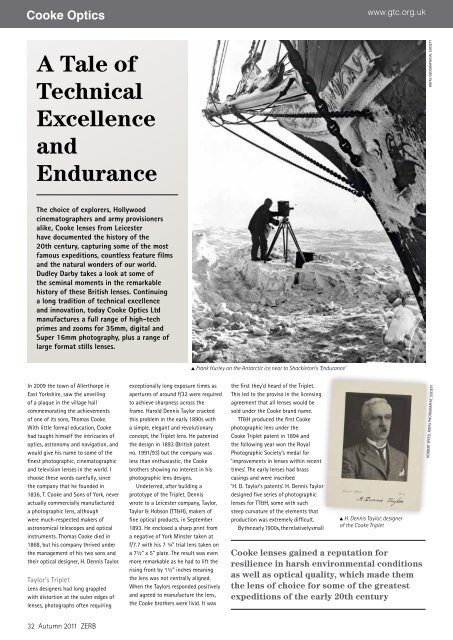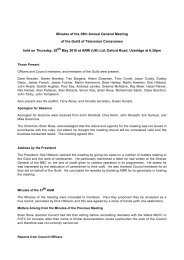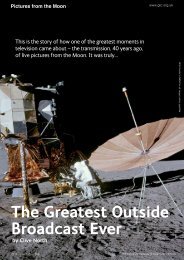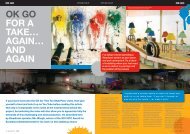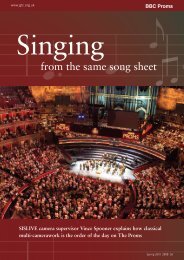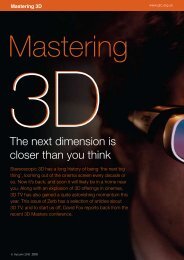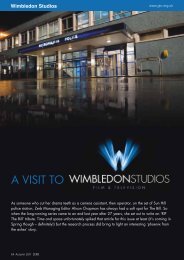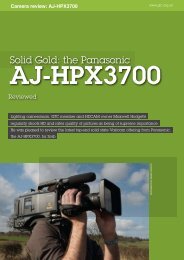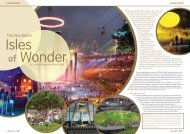Cooke Optics
Cooke Optics
Cooke Optics
You also want an ePaper? Increase the reach of your titles
YUMPU automatically turns print PDFs into web optimized ePapers that Google loves.
<strong>Cooke</strong> <strong>Optics</strong><br />
www.gtc.org.uk<br />
A Tale of<br />
Technical<br />
Excellence<br />
and<br />
Endurance<br />
royal geographicAL society<br />
The choice of explorers, Hollywood<br />
cinematographers and army provisioners<br />
alike, <strong>Cooke</strong> lenses from Leicester<br />
have documented the history of the<br />
20th century, capturing some of the most<br />
famous expeditions, countless feature films<br />
and the natural wonders of our world.<br />
Dudley Darby takes a look at some of<br />
the seminal moments in the remarkable<br />
history of these British lenses. Continuing<br />
a long tradition of technical excellence<br />
and innovation, today <strong>Cooke</strong> <strong>Optics</strong> Ltd<br />
manufactures a full range of high-tech<br />
primes and zooms for 35mm, digital and<br />
Super 16mm photography, plus a range of<br />
large format stills lenses.<br />
Frank Hurley on the Antarctic ice near to Shackleton’s ‘Endurance’<br />
In 2009 the town of Allerthorpe in<br />
East Yorkshire, saw the unveiling<br />
of a plaque in the village hall<br />
commemorating the achievements<br />
of one of its sons, Thomas <strong>Cooke</strong>.<br />
With little formal education, <strong>Cooke</strong><br />
had taught himself the intricacies of<br />
optics, astronomy and navigation, and<br />
would give his name to some of the<br />
finest photographic, cinematographic<br />
and television lenses in the world. I<br />
choose these words carefully, since<br />
the company that he founded in<br />
1836, T. <strong>Cooke</strong> and Sons of York, never<br />
actually commercially manufactured<br />
a photographic lens, although<br />
were much-respected makers of<br />
astronomical telescopes and optical<br />
instruments. Thomas <strong>Cooke</strong> died in<br />
1868, but his company thrived under<br />
the management of his two sons and<br />
their optical designer, H. Dennis Taylor.<br />
Taylor’s Triplet<br />
Lens designers had long grappled<br />
with distortion at the outer edges of<br />
lenses, photographs often requiring<br />
exceptionally long exposure times as<br />
apertures of around f/32 were required<br />
to achieve sharpness across the<br />
frame. Harold Dennis Taylor cracked<br />
this problem in the early 1890s with<br />
a simple, elegant and revolutionary<br />
concept, the Triplet lens. He patented<br />
the design in 1893 (British patent<br />
no. 1991/93) but the company was<br />
less than enthusiastic, the <strong>Cooke</strong><br />
brothers showing no interest in his<br />
photographic lens designs.<br />
Undeterred, after building a<br />
prototype of the Triplet, Dennis<br />
wrote to a Leicester company, Taylor,<br />
Taylor & Hobson (TT&H), makers of<br />
fine optical products, in September<br />
1893. He enclosed a sharp print from<br />
a negative of York Minster taken at<br />
f/7.7 with his 7 ¼” trial lens taken on<br />
a 7½” x 5” plate. The result was even<br />
more remarkable as he had to lift the<br />
rising front by 1½” inches meaning<br />
the lens was not centrally aligned.<br />
When the Taylors responded positively<br />
and agreed to manufacture the lens,<br />
the <strong>Cooke</strong> brothers were livid. It was<br />
the first they’d heard of the Triplet.<br />
This led to the proviso in the licensing<br />
agreement that all lenses would be<br />
sold under the <strong>Cooke</strong> brand name.<br />
TT&H produced the first <strong>Cooke</strong><br />
photographic lens under the<br />
<strong>Cooke</strong> Triplet patent in 1894 and<br />
the following year won the Royal<br />
Photographic Society’s medal for<br />
‘improvements in lenses within recent<br />
times’. The early lenses had brass<br />
casings and were inscribed<br />
‘H. D. Taylor’s patents’. H. Dennis Taylor<br />
designed five series of photographic<br />
lenses for TT&H, some with such<br />
steep curvature of the elements that<br />
production was extremely difficult.<br />
By the early 1900s, the relatively small<br />
H. Dennis Taylor, designer<br />
of the <strong>Cooke</strong> Triplet<br />
<strong>Cooke</strong> lenses gained a reputation for<br />
resilience in harsh environmental conditions<br />
as well as optical quality, which made them<br />
the lens of choice for some of the greatest<br />
expeditions of the early 20th century<br />
HERBERT SPEED, ROYAL PHOTOGRAPHIC SOCIETY<br />
32 Autumn 2011 ZERB
www.gtc.org.uk<br />
<strong>Cooke</strong> <strong>Optics</strong><br />
manufacturing company had grown<br />
and become a limited company.<br />
In addition to photographic and<br />
cinematographic lenses, they produced<br />
some Dennis Taylor designed object<br />
lenses for telescopes, notably a 2.5”<br />
aperture f/2 objective with a 30º field<br />
of view for the Mt Wilson Observatory<br />
in 1917.<br />
Prior to obtaining the <strong>Cooke</strong><br />
licence, TT&H already made a<br />
conditions as well as optical quality,<br />
which made them the lens of choice<br />
for some of the greatest expeditions<br />
of the early 20th century, the first of<br />
which was Ernest Shackleton’s 1914<br />
Antarctic Expedition. The expedition’s<br />
photographer, Frank Hurley, used a<br />
<strong>Cooke</strong> Series VIII 12” f/3.5 telephoto<br />
lens on a Graflex camera to record<br />
daily life on the ice as well as the<br />
destruction of the expedition’s ship,<br />
Sinclair camera produced excellent<br />
motion pictures of the climbers from<br />
two miles away. Both expeditions<br />
culminated in deaths on the mountain,<br />
the first climb claiming the lives of<br />
seven porters, the second those of<br />
George Mallory and Andrew Irvine.<br />
<strong>Cooke</strong> lenses were also used on<br />
other 1920s Polar expeditions, the<br />
United States Department of the<br />
Interior’s Alaskan Geological Survey,<br />
The Aviar<br />
The First World War and the advent<br />
of aerial reconnaissance brought a<br />
requirement for fast, high definition<br />
lenses. The Royal Flying Corps and<br />
Royal Naval Air Service had purchased<br />
‘suitable’ German lenses but, with<br />
German glass virtually impossible to<br />
procure, something new was needed.<br />
Arthur Warmisham, who had joined<br />
COOKE OPTICS<br />
TTH’s Stoughton<br />
Street premises in<br />
Leicester<br />
COOKE OPTICS<br />
Taylor Hobson<br />
<strong>Cooke</strong> advertisement<br />
with picture and<br />
endorsement<br />
sent by Sir Ernest<br />
Shackleton<br />
Captain John Noel<br />
using <strong>Cooke</strong> Series VIII 20”<br />
telephoto on Mt Everest<br />
royal geographicAL society<br />
soft-focus portrait lens called the<br />
Rapid View. This lens had achieved<br />
much acclaim through the works of<br />
Clarence White and Alfred Stieglitz<br />
in the early 1900s and demand for<br />
this type of lens led to an updated<br />
version with an added iris diaphragm,<br />
the <strong>Cooke</strong> Achromatic Portrait Lens<br />
f/7.5, produced in 1913. Focal lengths<br />
corresponded to the four most popular<br />
plate sizes. Various series of portrait<br />
lenses followed, all engraved with<br />
series numbers rather than names, the<br />
most popular being the Series II f/4.5.<br />
Expeditions<br />
<strong>Cooke</strong> lenses gained a reputation for<br />
resilience in harsh environmental<br />
Endurance, as it was slowly crushed.<br />
Many of Hurley’s glass negatives went<br />
down with the ship, but fine prints<br />
from those he salvaged can still be<br />
seen in exhibitions worldwide.<br />
Almost a decade later, Captain John<br />
Noel became official photographer<br />
to the Royal Geographic Society’s<br />
1922 and 1924 Everest expeditions<br />
led by Brigadier Charles Bruce. The<br />
photographic kit comprised three<br />
movie cameras, two panoramic<br />
cameras, four sheet cameras, a stereo<br />
camera and five small Kodak vest<br />
pocket devices that the climbers could<br />
take with them. Just as well they had<br />
some 160 porters! A <strong>Cooke</strong> Series<br />
VIII 20” f/5.6 Telephoto attached<br />
to a specially-built 40lb Newman<br />
The <strong>Cooke</strong> Aviar appeared at about<br />
the same time as William Vinten’s<br />
Model B aerial camera, and was<br />
adopted by the Royal Flying Corps<br />
and later the Royal Air Force<br />
expeditions to Africa and Asia, and<br />
aerial expeditions by Lt Cmdr Richard<br />
E. Byrd and Captain Amundsen over<br />
the North Pole by aeroplane and<br />
airship, respectively, in May 1926. The<br />
latter two expeditions used Taylor<br />
Hobson <strong>Cooke</strong> f/2.5 lenses attached to<br />
Bell & Howell Eyemo cameras.<br />
TT&H Ltd in 1912, took on the task<br />
of designing a new lens superior in<br />
performance to German lenses; the<br />
<strong>Cooke</strong> Aviar was patented in 1916<br />
(British patent 113590). It appeared<br />
at about the same time as William<br />
Vinten’s Model B aerial camera, and<br />
was adopted by the Royal Flying<br />
Autumn 2011 ZERB 33
COOKE OPTICS<br />
<strong>Cooke</strong> <strong>Optics</strong><br />
www.gtc.org.uk<br />
GOLDEN AGE TV<br />
Bell & Howell<br />
Eyemo Spyder<br />
with <strong>Cooke</strong> lenses<br />
Edmund Burke<br />
O’Connell, US<br />
Army newsreel<br />
cameraman with<br />
B&H Eyemo camera<br />
Used with permission from the authors of The Last Farewell - A Journey of the Heart, © 2006 Edmund Burke O’Connell, Julie Whitman<br />
Jones and Thomas J. Sullivan, Jr.<br />
COOKE OPTICS<br />
Arthur<br />
Warmisham, prolific<br />
designer of <strong>Cooke</strong><br />
lenses for 43 years<br />
Cylindrical slide rule and calculator used by Gordon Cook<br />
Corps and later the Royal Air Force. A<br />
post-war visit to the Stoughton Street<br />
factory by King George V and Queen<br />
Mary on 10 June 1919 recognized the<br />
company’s contribution to the war<br />
effort. In 1924, the Aviar, generally<br />
considered the finest Anastigmat<br />
ever to be produced, was adapted<br />
as a general photographic lens and<br />
continued in production in various<br />
focal lengths until the early 1960s.<br />
During the first half of the<br />
20th century, TT&H Ltd designed a<br />
variety of <strong>Cooke</strong> lenses for Graflex<br />
cameras. Perhaps the most desirable of<br />
these cameras was the Series C,<br />
a 3¼” x 4¼” still camera supplied<br />
with the <strong>Cooke</strong> 6½” f/2.5, their fastest<br />
lens for the Graflex range. Production<br />
continued from 1926 through to 1935.<br />
Making it in Hollywood<br />
As cinematography blossomed,<br />
particularly in Hollywood, the<br />
reputation of <strong>Cooke</strong> lenses spread.<br />
It was claimed that <strong>Cooke</strong> Series<br />
VIIIB Telephoto Anastigmat f/3.5<br />
lenses were being extensively used<br />
on Hollywood feature films. At the<br />
time, Famous Players-Lasky dominated<br />
production and distribution, and their<br />
DoP, Frank E Carbutt had written to<br />
TT&H in 1926 confirming that ‘over<br />
100 <strong>Cooke</strong> lenses of various focal<br />
lengths are used by the photographic<br />
department of Famous Players-Lasky<br />
studios’.<br />
Horace Lee, one of the most<br />
notable lens designers of the<br />
20th century, who joined TT&H in<br />
1913 as Arthur Warmisham’s assistant,<br />
designed the f/2 <strong>Cooke</strong> Speed Panchro<br />
in 1921, based on the very fast <strong>Cooke</strong><br />
Series O f/2.0 lens. With the advent<br />
of the ’talkies‘ signalling the demise<br />
of noisy arc lamps, this lens, first to<br />
market with a wider angular view and<br />
better definition at low light levels,<br />
would become extremely popular.<br />
Horace Lee subsequently became<br />
totally deaf and verbal communication<br />
with him was difficult, colleagues<br />
usually resorting to notes on pieces<br />
of paper.<br />
Together, Warmisham and Lee kept<br />
TT&H at the forefront of optical design<br />
engineering, rising to every challenge<br />
thrown up by advances in the film<br />
industry. Lens design in the 1920s<br />
and 1930s was a major undertaking.<br />
All calculations of light ray paths<br />
had to be performed manually by an<br />
army of female assistants known as<br />
’computers‘ using trigonometrical<br />
tables, mechanical calculators and<br />
Fuller’s cylindrical slide rules with<br />
helical scales 40 feet (12m) long. Two<br />
computers would work simultaneously<br />
and if their results agreed these were<br />
deemed to be accurate.<br />
Development of the 3-strip<br />
Technicolor camera with a beamsplitting<br />
prism behind the lens made<br />
it impossible to use existing wide<br />
angle, large aperture lenses. Again,<br />
an answer to the problem was found<br />
by Arthur Warmisham who came up<br />
with an inverted telephoto, patented<br />
in 1931. A year later, Lee patented the<br />
<strong>Cooke</strong> Series XV Triple Convertible, a<br />
combination still lens that provided<br />
three focal lengths, still popular with<br />
large format photographers.<br />
Working with Bell & Howell<br />
1931 also saw a partnership between<br />
TT&H and Bell & Howell of Chicago,<br />
makers of professional and amateur<br />
cine cameras. Arthur Warmisham,<br />
in collaboration with R.F. Mitchell<br />
of Bell & Howell, designed the first<br />
non-telescopic complex zoom lens<br />
for 35mm cameras, the <strong>Cooke</strong> Varo<br />
40–120mm (British patent 398,307,<br />
October 1932), manufactured and<br />
marketed by Bell & Howell. By 1935,<br />
the <strong>Cooke</strong> Speed Panchro range<br />
stretched to eight focal lengths from<br />
24mm to 108mm and accounted for<br />
the majority of Hollywood’s,<br />
34 Autumn 2011 ZERB
www.gtc.org.uk<br />
<strong>Cooke</strong> <strong>Optics</strong><br />
and indeed much of the world’s, film<br />
production. Bell & Howell’s Eyemo<br />
35mm camera, supplied exclusively<br />
with <strong>Cooke</strong> lenses, had sold well to the<br />
studios, later becoming standard issue<br />
for camera operators during World<br />
War II. George Eastman commented<br />
to William Taylor that “90% of 16mm<br />
film used in America passed behind<br />
lenses made in Leicester”.<br />
Around this time, Horace Lee<br />
decided to move on. Charles Wynne,<br />
a TB sufferer and ex-ladder salesman<br />
with an Oxford physics degree in<br />
optics, replaced him, taking over his<br />
desk which sported a large prototype<br />
lens as a paperweight and numerous<br />
most for any single optical designer,<br />
and Series II and III Speed Panchros<br />
were developed, including an 18mm<br />
80º variant for widescreen Technicolor.<br />
Significantly, there was a move into<br />
the amateur market, RTH supplying<br />
<strong>Cooke</strong> lenses in various guises for all<br />
of Bell & Howell’s 16mm and 8mm<br />
cameras. Television also beckoned.<br />
Dallmeyer had dominated the early<br />
United Kingdom TV market, but with<br />
the advent of the Image Orthicon,<br />
RTH came to the fore with fixed focus<br />
turret lenses (the Ortal and Vidital<br />
ranges designed by Gordon H. Cook)<br />
and the Varotal 1, 2 and 3 zoom<br />
lenses. The Bowden cable-operated<br />
its fortunes declined as a small,<br />
and somewhat neglected, part of<br />
Rank. Eventually, in 1997, it was<br />
sold to Schroders Ventures. For<br />
some time Taylor Hobson had been<br />
manufacturing fine metrology<br />
instrumentation, and by July a year<br />
later decided that that was its future.<br />
The optics division of the company<br />
was sold to Les Zellan, a long-time<br />
distributor of <strong>Cooke</strong> lenses in the<br />
United States, and firm believer in<br />
the principles of innovation and<br />
optical design excellence established<br />
by the Taylor brothers a little more<br />
than a century earlier. <strong>Cooke</strong> lenses<br />
were being produced by a dedicated<br />
T2.0 primes, then the development of<br />
/i Technology, digital technology that<br />
allows lens data to be recorded along<br />
with each frame. Thales-Angénieux,<br />
recognising its benefits, formed a<br />
collaborative partnership with <strong>Cooke</strong><br />
<strong>Optics</strong> Ltd to introduce it on their<br />
range of film lenses.<br />
IBC 2009 saw the launch of the<br />
<strong>Cooke</strong> 5/i, T1.4 series of Super 35<br />
lenses and a prototype of a totally<br />
new rework of one of <strong>Cooke</strong>’s classics,<br />
the Panchro by <strong>Cooke</strong>, both of which<br />
Mark Gerchman’s team had designed.<br />
The f2.8 Panchro lenses would provide<br />
a lower cost compact option for<br />
shooting situations where T2.8 is<br />
George Eastman commented to<br />
William Taylor that “90% of 16mm<br />
film used in America passed<br />
behind lenses made in Leicester”<br />
notes for Lee. Warmisham and<br />
Wynne investigated the possibilities<br />
of designing lenses using crystalline<br />
materials which led to a number of<br />
early patents in this field, but didn’t<br />
result in any practical lens designs at<br />
that time.<br />
The early 1940s saw uneasiness<br />
among some of the younger design<br />
staff over the company’s tight-fisted<br />
approach to money management.<br />
Wynne recalled a time when he was<br />
off sick and was sent his wages in a<br />
linen, registered envelope, the cost<br />
of which had been deducted. As was<br />
permitted by the Post Office at that<br />
time, he returned the envelope to its<br />
sender (the company), who were then<br />
required to refund the cost – two<br />
pence more than the deduction! He<br />
left TT&H in 1943 and became known<br />
in the 1950s for his work that would<br />
ultimately lead to computer-aided<br />
lens design.<br />
Rank Taylor Hobson<br />
Process prisms and <strong>Cooke</strong><br />
Apochromatic process lenses, the first<br />
of British design, had been produced<br />
since 1921. During World War II,<br />
these were used for high-quality<br />
map production for the armed forces,<br />
and by 1947 an estimated 75% of<br />
photoengravers in the United Kingdom<br />
and America were using <strong>Cooke</strong> brand<br />
lenses. By then, TT&H had been<br />
acquired by the Rank Organisation<br />
and become Rank Taylor Hobson<br />
(RTH). Changes were afoot. Arthur<br />
Warmisham retired in 1955 with some<br />
99 optical patents to his name, the<br />
Varotal 2 covered less focal length<br />
range than a standard turret, so was<br />
really only of use in studios whereas<br />
the Varotal 1 had an 8”–40” range<br />
more suited to outside use. As they<br />
were not film lenses, they didn’t<br />
carry the <strong>Cooke</strong> name. Longer range<br />
OB zooms were later developed,<br />
production continuing until the<br />
late 1960s.<br />
Professional 16mm cameras and<br />
film stock quality had improved to the<br />
point where they were becoming a<br />
cost-effective alternative to 35mm in<br />
some environments, so the company<br />
responded by producing nine wide<br />
aperture 16mm prime lenses.<br />
Zoom lenses<br />
With the advent of colour television,<br />
zoom lenses became the norm. Taylor<br />
Hobson <strong>Optics</strong>, as the division was<br />
known, produced new servo-controlled<br />
variants in the Varotal range to fit<br />
the four-tube Marconi Mk VII and<br />
much-loved EMI2001 cameras, among<br />
others. Gordon Cook also produced<br />
a new design of film zoom with a<br />
fixed front element and sealed focus<br />
unit which remained the basis for<br />
<strong>Cooke</strong>’s later range of film zooms and<br />
helped earn him the 1988 Donald E.<br />
Sawyer Award from the Academy of<br />
Motion Picture Arts and Sciences for<br />
technological advances during his<br />
career.<br />
Competition in the lucrative<br />
television lens market from France,<br />
Germany and Japan was fierce.<br />
Although the company won a Design<br />
Council award for the Varotal 30,<br />
The new and the old. A state of the art <strong>Cooke</strong> 5/i 25mm lens with 1932 <strong>Cooke</strong> Varo<br />
40-120mm, the first zoom lens.<br />
company, <strong>Cooke</strong> <strong>Optics</strong> Ltd.<br />
Announced before the end of<br />
1998, design of the award-winning<br />
S4 T2.0 series was completed by Mark<br />
Gerchman, <strong>Cooke</strong>’s talented new<br />
chief optical designer, capturing<br />
a large chunk of the digital<br />
cinematography market. The<br />
company moved across Leicester to<br />
new 20,000 square feet premises as<br />
the 21st century commenced. Two<br />
large-format photographic lenses<br />
(PS945 and XVa Triple Convertible)<br />
followed, the first new <strong>Cooke</strong> still<br />
lenses in 50 years, SK4 Super 16mm<br />
Fact File<br />
adequate. The three series of lenses,<br />
S4, 5/i, and Panchro by <strong>Cooke</strong> are<br />
colour matched allowing a mix and<br />
match of lenses<br />
William Taylor’s philosophy of “not<br />
doing what everyone else was doing,<br />
but doing something new” has been<br />
maintained by <strong>Cooke</strong> lens designers<br />
through the various incarnations<br />
of the same company, and always<br />
designed and crafted in Leicester<br />
facilities, touching three centuries<br />
now. What of the future? Wait and<br />
see. It is bound to be something<br />
spectacular.<br />
Dudley Darby worked for BBC TV from 1963–2001 on camera, mainly<br />
multi-camera in the studios. He also undertook operational evaluations<br />
of equipment, and was involved with H&S as a safety rep. He has been<br />
freelance since 2001 on both studio multi-camera and location single<br />
camera shoots. Read Dudley Darby’s article about the high-precision<br />
techniques involved in making <strong>Cooke</strong> lenses in Zerb 71, Spring 2010.<br />
<strong>Cooke</strong> <strong>Optics</strong> Ltd, <strong>Cooke</strong> Close, Thurmaston, Leicester, LE4 8PT. UK<br />
Tel: 0116 264 0700<br />
Email: lenses@cookeoptics.com<br />
Web: www.cookeoptics.com<br />
The photo of Edmund Burke O’Connell comes from ‘The Last Farewell’<br />
by Julie Whitman Jones and Thomas J Sullivan Jnr, a memoir of war<br />
photographer O’Connell seen through the viewfinder of his still and B&H<br />
Eyemo camera during the Italian campaign of the Second World War.<br />
More about the book at: www.thelastfarewell.net<br />
Autumn 2011 ZERB 35


